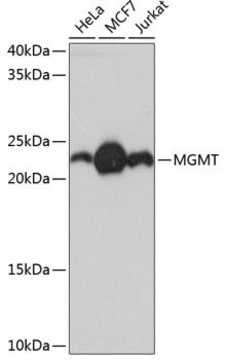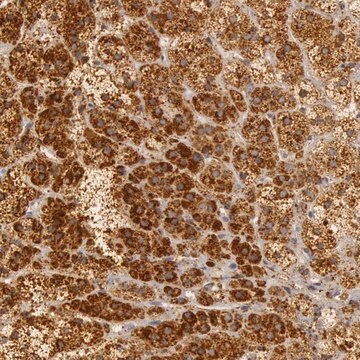推荐产品
生物源
goat
共軛
unconjugated
抗體表格
affinity isolated antibody
抗體產品種類
primary antibodies
無性繁殖
polyclonal
形狀
lyophilized powder
物種活性
human
技術
capture ELISA: 0.2-0.8 μg/mL
flow cytometry: 2.5 μg using 106 human T cells treated with PHA
immunocytochemistry: 5-15 μg/mL
western blot: 0.1 μg/mL
雜質
<0.10 EU/μg endotoxin
UniProt登錄號
儲存溫度
−20°C
目標翻譯後修改
unmodified
基因資訊
human ... TNFRSF9(3604)
一般說明
CD137 (4-1BB) is a member of the tumor necrosis factor (TNF) receptor superfamily. It is a type I transmembrane glycoprotein expressed on the cell surface of activated splenic T cells and thymocytes.
免疫原
mouse myeloma cell line NS0-derived recombinant human 41BB/TNFRSF9/CD137 Leu24Gln186
應用
Anti-CD137 antibody produced in goat is suitable for the following applications:
- Agonist Activity: Measured by its ability to costimulate IFNg secretion by human T cells in the presence of anti-CD3. The ED50 for this effect is typically 5-20μg/mL.
- ELISA capture: It can be used as a capturing reagent in a human 4-1BB sandwich immunoassay in combination with biotinylated human 4-1BB detection antibody and recombinant human 4-1BB as the standard. The suggested coating concentration range is 0.2-0.8μg/ml. The recommended concentration of the detection antibody is 0.1-0.4μg/mL.
- Flow cytometry: 2.5μg/106 cells using Human T cells treated with PHA (phytohemagglutinin).
- Immunoblotting: A working concentration of 0.1μg/ml was determined using recombinant human CD137.
- Immunocytochemistry: 5-15μg/mL using immersion fixed human peripheral blood mononuclear cells.
生化/生理作用
CD137 in T lymphocytes helps to regulate activation, proliferation and apoptosis. CD137 and CD28 are co-stimulatory molecules of T cell activation. It plays an important role in regulating T-cell-dependent immune responses. The expression of CD137 correlates negatively with lymphocyte proliferation and induces cell death caused by mitogen overstimulation. In monocytes, CD137 induces activation, promotes adherence and helps in prolongs survival.
外觀
Lyophilized from a 0.2 μm filtered solution in phosphate buffered saline with 5% trehalose.
重構
Reconstitute at 0.2 mg/mL in sterile PBS
免責聲明
Unless otherwise stated in our catalog or other company documentation accompanying the product(s), our products are intended for research use only and are not to be used for any other purpose, which includes but is not limited to, unauthorized commercial uses, in vitro diagnostic uses, ex vivo or in vivo therapeutic uses or any type of consumption or application to humans or animals.
Not finding the right product?
Try our 产品选型工具.
儲存類別代碼
10 - Combustible liquids
水污染物質分類(WGK)
WGK 1
閃點(°F)
Not applicable
閃點(°C)
Not applicable
J C Hurtado et al.
Journal of immunology (Baltimore, Md. : 1950), 155(7), 3360-3367 (1995-10-01)
The expression of the murine T cell Ag 4-1BB, a member of the TNF-R family, is induced by T cell activation. Previously, we and others had shown that signaling through 4-1BB enhanced proliferative T cell responses. To investigate a potential
H H Kim et al.
Molecules and cells, 10(3), 247-252 (2000-07-20)
It has been widely accepted that T cell activation requires two signals; one from the binding of the antigen/major histocompatibility complex to the T-cell receptor (TCR)/CD3 complex and the other from the interaction between a surface molecule on antigen presenting
J Michel et al.
Cytokine, 12(6), 742-746 (2000-06-14)
CD137 is a member of the tumour necrosis factor receptor family which delivers a potent co-stimulatory signal to T lymphocytes. Soluble forms of CD137 (sCD137) can be found at enhanced levels in sera of patients with rheumatoid arthritis. Here we
G Kienzle et al.
International immunology, 12(1), 73-82 (1999-12-23)
Human CD137 is a member of the tumor necrosis factor (TNF) receptor family and the homologue of murine 4-1BB. Recent studies have demonstrated that CD137 promotes accessory T cell activation, and regulates proliferation and survival of T lymphocytes. This study
J Langstein et al.
Journal of leukocyte biology, 65(6), 829-833 (1999-06-25)
CD137 (ILA/4-1BB), a member of the tumor necrosis factor (TNF) receptor family, promotes adherence and prolongs survival of human peripheral monocytes. It induces a strong expression of macrophage colony-stimulating factor (M-CSF), an essential monocyte survival factor. Monocyte survival induced by
我们的科学家团队拥有各种研究领域经验,包括生命科学、材料科学、化学合成、色谱、分析及许多其他领域.
联系技术服务部门








